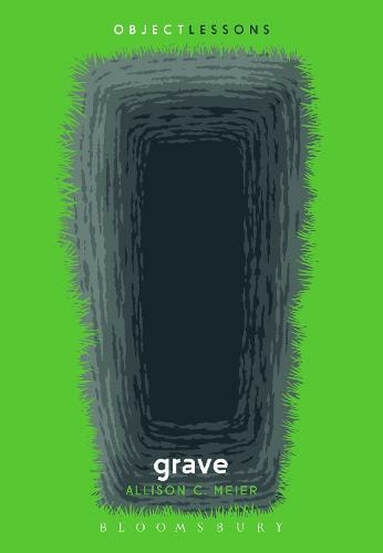
TITLE: Grave (Object Lessons)
AUTHOR: Allison C. Meier
PUBLISHER: Bloomsbury
ISBN: 9781501383656
PODCAST EPISODE: None
REVIEWER: Hilary Wilson
Bloomsbury Academic’s Object Lesson series is a wondrous collection that teaches its readers how to appreciate the ordinary. Each of these concise books seeks to thoroughly analyze a singular aspect of day-to-day life. Previous publications within this series look at subjects such as Traffic or the High Heel. The latest addition to the series, released in February 2023, is Grave by Allison C. Meier.
Meier has worked as a cemetery tour guide in New York City since 2011. An accomplished writer, her previous credits include publications within National Geographic, Mental Floss, and the Order of the Good Death. She is also the senior editor of Atlas Obscura. Her passion for bringing attention to little-known people and bits of history serves her well in Grave, as so much of what surrounds the topic of death and dying is often forgotten.
Grave is a concise book, coming in at under 200 pages even including the ample citations. The short essays begin with Meier explaining her own fascination with the historic cemetery near where she lived and how she found herself as one of its guides. Throughout the book, she explains how society has changed its view of death and dying. Once, people were buried in graveyards and burial grounds, full of reminders of one’s own mortality. But now, we are buried in cemeteries, the progenitors of the more common community park. Less hidden from view, especially in the aftermath of the COVID-19 Pandemic, she makes the argument that our views of death are once more changing.
Meier pays careful attention to how death is dealt with among the poor, indigent, and minority communities, affording a broader view of history than many other texts. She also takes care to explain why practices such as cremation and embalming, both of which have been and still remain controversial among certain subsets of the population, can be viewed as positive things to others. There is no wrong way to die and to grieve, and this book covers some of the wide variety of ways people have gone about both.
This book is an interesting, contemplative read. Of particular interest is Meier’s attention to how funeral practices of the future might look. Recomposition, mushroom suits, and water cremation are all intriguing answers to problems that few want to seriously consider. Our cemeteries are filling up, and we are more nomadic now as a race than we have been in some time. Treks to visit our familial dead are less feasible in this globalized society, nor is it any more feasible to transport everybody back to their ancestral plots. Mausoleums are the way of the past – but the future is moving towards new options, many of which are friendlier to the environment. Meier forces the reader to consider their own mortality and what they might wish to happen to their body after they pass.
AUTHOR: Allison C. Meier
PUBLISHER: Bloomsbury
ISBN: 9781501383656
PODCAST EPISODE: None
REVIEWER: Hilary Wilson
Bloomsbury Academic’s Object Lesson series is a wondrous collection that teaches its readers how to appreciate the ordinary. Each of these concise books seeks to thoroughly analyze a singular aspect of day-to-day life. Previous publications within this series look at subjects such as Traffic or the High Heel. The latest addition to the series, released in February 2023, is Grave by Allison C. Meier.
Meier has worked as a cemetery tour guide in New York City since 2011. An accomplished writer, her previous credits include publications within National Geographic, Mental Floss, and the Order of the Good Death. She is also the senior editor of Atlas Obscura. Her passion for bringing attention to little-known people and bits of history serves her well in Grave, as so much of what surrounds the topic of death and dying is often forgotten.
Grave is a concise book, coming in at under 200 pages even including the ample citations. The short essays begin with Meier explaining her own fascination with the historic cemetery near where she lived and how she found herself as one of its guides. Throughout the book, she explains how society has changed its view of death and dying. Once, people were buried in graveyards and burial grounds, full of reminders of one’s own mortality. But now, we are buried in cemeteries, the progenitors of the more common community park. Less hidden from view, especially in the aftermath of the COVID-19 Pandemic, she makes the argument that our views of death are once more changing.
Meier pays careful attention to how death is dealt with among the poor, indigent, and minority communities, affording a broader view of history than many other texts. She also takes care to explain why practices such as cremation and embalming, both of which have been and still remain controversial among certain subsets of the population, can be viewed as positive things to others. There is no wrong way to die and to grieve, and this book covers some of the wide variety of ways people have gone about both.
This book is an interesting, contemplative read. Of particular interest is Meier’s attention to how funeral practices of the future might look. Recomposition, mushroom suits, and water cremation are all intriguing answers to problems that few want to seriously consider. Our cemeteries are filling up, and we are more nomadic now as a race than we have been in some time. Treks to visit our familial dead are less feasible in this globalized society, nor is it any more feasible to transport everybody back to their ancestral plots. Mausoleums are the way of the past – but the future is moving towards new options, many of which are friendlier to the environment. Meier forces the reader to consider their own mortality and what they might wish to happen to their body after they pass.